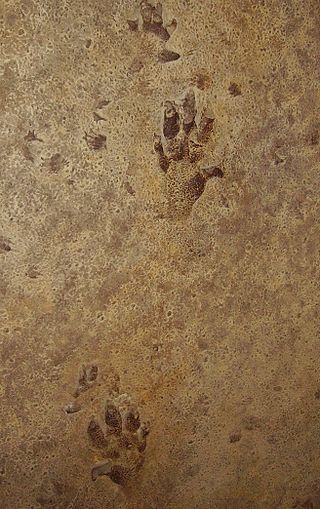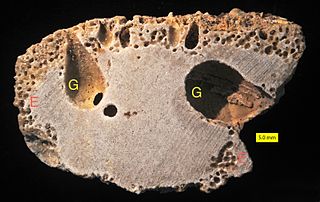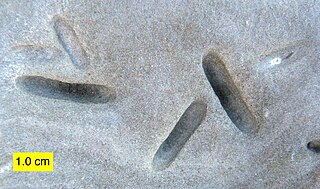
Petrified Forest National Park is an American national park in Navajo and Apache counties in northeastern Arizona. Named for its large deposits of petrified wood, the park covers about 346 square miles, encompassing semi-desert shrub steppe as well as highly eroded and colorful badlands. The park's headquarters is about 26 miles (42 km) east of Holbrook along Interstate 40 (I-40), which parallels the BNSF Railway's Southern Transcon, the Puerco River, and historic U.S. Route 66, all crossing the park roughly east–west. The site, the northern part of which extends into the Painted Desert, was declared a national monument in 1906 and a national park in 1962. The park received 644,922 recreational visitors in 2018.

A trace fossil, also known as an ichnofossil, is a fossil record of biological activity by lifeforms but not the preserved remains of the organism itself. Trace fossils contrast with body fossils, which are the fossilized remains of parts of organisms' bodies, usually altered by later chemical activity or mineralization. The study of such trace fossils is ichnology and is the work of ichnologists.

Petrified wood, also known as petrified tree, is the name given to a special type of fossilized wood, the fossilized remains of terrestrial vegetation. Petrifaction is the result of a tree or tree-like plants having been replaced by stone via a mineralization process that often includes permineralization and replacement. The organic materials making up cell walls have been replicated with minerals. In some instances, the original structure of the stem tissue may be partially retained. Unlike other plant fossils, which are typically impressions or compressions, petrified wood is a three-dimensional representation of the original organic material.

Araucarioxylon arizonicum is an extinct species of conifer that is the state fossil of Arizona. The species is known from massive tree trunks that weather out of the Chinle Formation in desert badlands of northern Arizona and adjacent New Mexico, most notably in the 378.51 square kilometres Petrified Forest National Park. There, these trunks are locally so abundant that they have been used as building materials.

The Chinle Formation is an Upper Triassic continental geological formation of fluvial, lacustrine, and palustrine to eolian deposits spread across the U.S. states of Nevada, Utah, northern Arizona, western New Mexico, and western Colorado. In New Mexico, it is often raised to the status of a geological group, the Chinle Group. Some authors have controversially considered the Chinle to be synonymous to the Dockum Group of eastern Colorado and New Mexico, western Texas, the Oklahoma panhandle, and southwestern Kansas. The Chinle Formation is part of the Colorado Plateau, Basin and Range, and the southern section of the Interior Plains. A probable separate depositional basin within the Chinle is found in northwestern Colorado and northeastern Utah. The southern portion of the Chinle reaches a maximum thickness of a little over 520 meters (1,710 ft). Typically, the Chinle rests unconformably on the Moenkopi Formation.

Otozoum is an extinct ichnogenus of sauropodomorph dinosaur from the Late Triassic-Middle Jurassic sandstones. Footprints were made by heavy, bipedal or, sometimes, quadrupedal animals with a short stride that walked on four toes directed forward. These footprints are relatively large, over 20 cm in pes length. Otozoum differs from Plateosaurus by having a notable homopody.
Brutalichnus is an ichnogenus. A case study from the Miocene of the Czech Republic found that Brutalichnus and two other ichnogenera have evidence of biting and gnawing traces on reptilian and mammalian bones. Brutalichnus contains one ichnospecies, Brutalichnusbrutalis. The ichnogenera Machichnus and Nihilichnus were described in the same paper.
Machichnus is an ichnogenus. It was erected by Mikuláš et al. (2006) for shallow, thin, discrete, parallel to subparallel, smooth-bottomed scratches, occurring on bone tissue in small groups or series. According to modern analogues, the series of scratches represent marks of teeth of carnivorous or scavenging reptilians and mammals. Such traces are quite frequent in the fossil record since the mid-Mesozoic, but they have seldom been described in detail.
Nihilichnus is an ichnogenus of trace fossil. It was first described from bite traces in 2006. The ichnogenus originally contained two ichnospecies, Nihilichnus nihilicus and Nihilichnus mortalis. The ichnogenera Brutalichnus and Machichnus were described in the same paper.
Rioarribasuchus is a genus of aetosaur. Fossils have been found from the Chinle Formation in Arizona and New Mexico that date back to the upper Late Carnian stage of the Late Triassic.

Gastrochaenolites is a trace fossil formed as a clavate (club-shaped) boring in a hard substrate such as a shell, rock or carbonate hardground. The aperture of the boring is narrower than the main chamber and may be circular, oval, or dumb-bell shaped. Gastrochaenolites is most commonly attributed to bioeroding bivalves such as Lithophaga and Gastrochaena. The fossil ranges from the Ordovician to the Recent. The first Lower Jurassic Gastrochaenolites ichnospecies is Gastrochaenolites messisbugi Bassi, Posenato, Nebelsick, 2017. This is the first record of boreholes and their producers in one of the larger bivalves of the globally occurring Lithiotis fauna which is a unique facies in the Lower Jurassic Tethys and Panthalassa.
The Chinle Formation is an extensive geological unit in the southwestern United States, preserving a very diverse fauna of Late Triassic animals and plants. This is a list of fossilized organisms recovered from the formation.

Petroxestes is a shallow, elongate boring originally found excavated in carbonate skeletons and hardgrounds of the Upper Ordovician of North America. These Ordovician borings were likely made by the mytilacean bivalve Corallidomus as it ground a shallow groove in the substrate to maintain its feeding position. They are thus the earliest known bivalve borings. Petroxestes was later described from the Lower Silurian of Anticosti Island (Canada). and the Miocene of the Caribbean.
Pravusuchus is an extinct genus of leptosuchomorph parasuchid phytosaur known from the Late Triassic of Arizona, United States. It contains a single species, Pravusuchus hortus, which is known from three specimens. These specimens were previously referred to Smilosuchus or to Leptosuchus, but Pravusuchus's autapomorphy, its phylogenetic position as well as a trait shared with mystriosuchins, justified the erection of a new taxon for the material.

The Shinarump Conglomerate is a geologic formation found in the Four Corners region of the United States. It was deposited in the early part of the Late Triassic period.

The Curtis Formation is a geologic formation in Utah. It preserves fossils dating back to the Callovian age of the Jurassic period.

The Rock Point Formation is a geologic formation in New Mexico, Arizona, and Utah. It preserves fossils dating back to the late Triassic.
This article records new taxa of trace fossils of every kind that are scheduled to be described during the year 2019, as well as other significant discoveries and events related to trace fossil paleontology that are scheduled to occur in the year 2019.

The Poleo Formation is a geologic formation in northern New Mexico. Its stratigraphic position corresponds to the late Triassic epoch.











